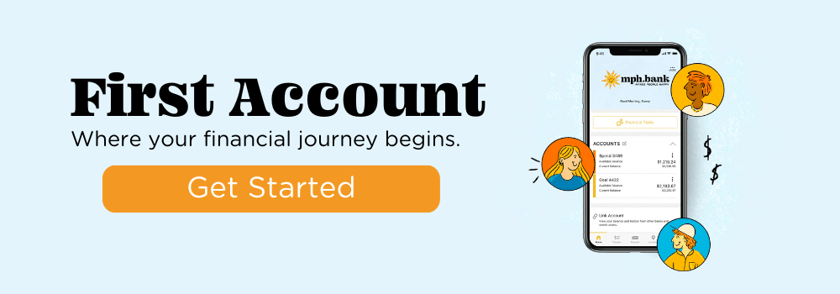Let's face it, juggling textbooks, late-night study sessions, and that ever-present cup of ramen noodles is enough to keep your brain buzzing. But when it comes to your finances, navigating the world of bank accounts can feel like deciphering ancient hieroglyphics – especially when whispers of "monthly fees" echo in the bank halls.
Related Article: 7 Tools and Apps For Shared Money Management
Fear not, financial friends! This post is your decoder ring for cracking the code of student checking accounts and those pesky fees. We'll unveil the truth: not all student accounts come with a monthly fee burden, and knowing how to spot the right one can leave you with more cash for that extra slice of pizza (or whatever fuels your late-night cram sessions). So, grab your notebooks, put on your thinking caps, and let's dive into the fascinating world of student banking!
Remember, knowledge is power, and financial knowledge is super-power. By the end of this post, you'll be able to choose a student checking account that works for you, not against you, leaving you free to focus on mastering your studies and conquering that next exam. Buckle up, because the quest for fee-free banking starts now!
Why are fees charged for student accounts?
Before we tackle those monthly fees head-on, it's time for a quick lesson in Bank Fee Economics 101. While it might feel like banks are just eager to snatch a few extra dollars from your hard-earned stash, there's actually some logic behind their fee structures. Picture it like this: running a bank is like keeping a massive library of books organized and accessible – but instead of books, they're managing your money and everyone else's.
Here's a quick breakdown of the reasons behind those fees:
- Keeping the Lights On: Banks have expenses too, like paying their staff, maintaining fancy ATM machines, and investing in security systems to keep your money safe. Monthly service fees help cover these costs.
- Encouraging Good Habits: Some fees, like overdraft charges, are designed to nudge you towards responsible banking habits. They're like those stern reminders from your favorite professor to turn in assignments on time – a little push to keep you on track.
- Different Accounts, Different Rules: Student checking accounts often have unique fee structures compared to regular checking accounts. Think of it as a student discount – banks recognize that you're just starting your financial journey, so they might offer more flexibility to help you learn the ropes.
Now that you understand the rationale behind bank fees, let's decode the specific types you might encounter:
- Monthly Service Fees: Think of this as a membership fee for using the bank's services. It's a fixed amount charged every month, usually around $5 to $10.
- ATM Fees: These pop up when you withdraw cash from an ATM outside of your bank's network. They can range from a couple of bucks to $5 or more per transaction.
-
- Overdraft Fees: These are penalties for spending more than you have in your account. They can be steep, often around $35 per overdraft.
Do all student checking accounts have monthly fees?
Cue the trumpets and celebratory confetti, because we're about to reveal a truth that could transform your financial life: Not all student checking accounts come with monthly fees! That's right, banks have realized that students are pretty awesome and deserve a break, so they've crafted special accounts designed to keep those fees at bay.
Here's the inside scoop on how to spot these fee-free gems:
- Look for the "Student" Label: Many banks offer accounts specifically tailored for students, often with names like "Student Checking" or "College Checking." These accounts often waive monthly service fees as long as you meet certain conditions, like being enrolled in school or maintaining a minimum balance.
- Consider Age Requirements: Some banks offer fee-free accounts to those under a certain age, typically 18-24 years old. This is a great perk if you're starting your banking journey early.
- Read the Fine Print: Just like deciphering a complex lab report, it's crucial to carefully read the account terms and conditions. Look for any requirements to maintain fee-free status, such as making a minimum number of transactions or setting up direct deposit.
Here are a few examples of banks known for their fee-friendly student checking accounts:
- Chase College Checking: No monthly service fees for up to 5 years while you're in school.
- Bank of America Advantage SafeBalance Banking: No monthly maintenance fees if you're under 25 and enrolled in school.
- Capital One MONEY: No monthly fees or minimum balance requirements, designed for students ages 8-18.
- mph.bank's First Account: No monthly fees or minimum balance requirements. Perfect for ages 14 - 24
Remember, knowledge is your superpower when it comes to choosing the right account. By doing your research and comparing options, you can find a student checking account that aligns with your financial needs and goals, leaving you free to focus on mastering those textbooks (and maybe treating yourself to a well-deserved study break snack)
Factors to consider when choosing a student checking account
Now that you're armed with the knowledge of fee-free options, it's time to navigate the maze of features and find the account that best suits your lifestyle. Just like choosing the right courses for your semester, selecting a checking account requires careful consideration. Here are the key factors to keep in mind:
1. Monthly Fees and Waiver Options:
- Compare fee structures: Check for monthly service fees, minimum balance requirements, and any conditions for fee waivers.
- Look for student-friendly accounts: Prioritize accounts specifically designed for students, as they often have more generous fee waiver policies.
2. ATM Network Access:
- Identify convenient ATMs: See if the bank has ATMs near your campus, home, or frequently visited locations.
- Consider out-of-network fees: Understand any charges associated with using ATMs outside the bank's network.
- Look for banks with extensive ATM networks: This can help you avoid those pesky out-of-network fees.
3. Account Features:
- Debit cards: Ensure the account offers a debit card for easy access to your funds.
- Mobile banking and online access: Check for user-friendly mobile apps and online banking features to manage your account on the go.
- Reward programs: Some student accounts offer rewards for good banking habits, like cash back or points.
4. Bank Convenience:
- Branch availability: If you prefer in-person banking, consider the bank's branch locations and hours.
- Customer service: Research the bank's reputation for customer service and responsiveness.
5. Additional Considerations:
- Overdraft protection: Ask about overdraft options and fees to avoid costly surprises.
- Security features: Ensure the bank has robust security measures to protect your account information.
-
- Financial education resources: Some banks offer financial literacy tools and resources specifically for students.
Tips for minimizing fees in student checking accounts
Now that you've navigated the account maze, it's time to level up your financial skills and learn how to keep those fees in check. Think of it as outsmarting the final boss in a video game – with the right strategies, you can emerge victorious!
Here are some pro tips to minimize fees and protect your hard-earned cash:
1. Maintain Minimum Balances (If Applicable):
- If your account has a minimum balance requirement to avoid fees, make sure you consistently meet it. Set up automatic transfers or reminders to stay on top of your balance.
2. Set Up Direct Deposit:
- Many banks waive monthly service fees if you have a direct deposit set up, such as your paycheck or student loan disbursements. This is an easy way to keep fees at bay without extra effort.
3. Stick to the Network:
- Use your bank's ATMs or online banking for transactions whenever possible to avoid out-of-network ATM fees.
- If you need cash while out and about, consider using cashback options at stores to bypass ATM fees altogether.
4. Monitor Your Balance and Avoid Overdrafts:
- Keep a close eye on your account balance to prevent overdrafts, which can result in hefty fees. Utilize mobile banking apps and alerts to stay informed.
- If you're worried about overdrafts, opt-in for overdraft protection or link your account to a savings account for backup funds.
5. Don't Be Afraid to Switch:
- If your current student account is charging high fees, don't hesitate to explore other options. Many banks offer fee-free student accounts, so it's worth shopping around to find one that best suits your needs.
Student Checking account fees Summary
You've now reached the final chapter of this student checking account adventure, equipped with the knowledge and tools to navigate the world of fees like a pro. Remember, the key to financial success lies in making informed choices and taking action.
Here's a quick recap of the key takeaways:
- Not all student checking accounts have monthly fees. Seek out those fee-free gems by exploring student-specific accounts and understanding bank requirements.
- Compare features and benefits to find an account that aligns with your lifestyle and financial needs. Consider ATM access, account features, and bank convenience.
- Actively manage your account to minimize fees. Maintain minimum balances (if applicable), set up direct deposit, use in-network ATMs, and monitor your balance to avoid overdrafts.
- Don't hesitate to switch if your current account isn't serving you well. There are plenty of fee-friendly options out there, so explore and find the best fit for you.
Your quest for fee-free banking doesn't end here. Continue to level up your financial skills by:
- Researching different banks and accounts to compare options and find the best deals.
- Reading the fine print of account terms and conditions to fully understand fees and requirements.
- Reaching out to bank representatives to ask questions and clarify any uncertainties.
- Seeking advice from financial counselors or trusted advisors for personalized guidance.
Remember, you're not alone on this journey. There are plenty of resources available to help you make informed financial decisions. So, stay curious, keep learning, and conquer those fees like the financial champion you are!
What do fish use as currency to purchase anything?
Sand Dollars! Sign up to receive important information on banking, financial tips, and jokes like this directly to your inbox










